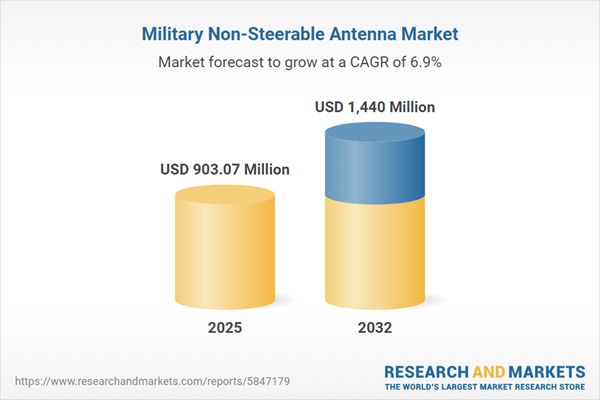Speak directly to the analyst to clarify any post sales queries you may have.
Military non-steerable antennas underpin secure and reliable communications for defense organizations adapting to complex mission demands and heightened security pressures. As the defense landscape evolves, senior decision-makers require robust connectivity solutions to ensure operational agility and coordinated response capabilities.
Market Snapshot: Military Non-Steerable Antenna Market
The global military non-steerable antenna market continues to show stable growth, driven by significant investments in advanced communications infrastructure and sustained modernization efforts within defense agencies. With a projected compound annual growth rate (CAGR) of 6.94% through 2032, this sector’s upward trajectory reflects ongoing priorities around secure and interoperable communications. Digital transformation across defense operations has intensified the need for coordinated connectivity that supports real-time exchanges and seamless integration across joint operations. Non-steerable antennas remain critical for mission-critical communications, supporting defense and homeland security directives as organizations adapt to dynamic operational environments and increasingly sophisticated security threats.
Scope & Segmentation of the Military Non-Steerable Antenna Market
- Applications: Non-steerable antennas enable secure voice and data transfers, support electronic warfare coordination, provide satellite communications, and facilitate navigation solutions for intelligence sharing and effective countermeasure implementation.
- End Users: The Air Force, Army, Navy, and Homeland Security sectors deploy these antennas to enhance situational awareness, maintain operational preparedness, and establish robust command frameworks.
- Frequency Bands: Versatile coverage across EHF, HF, SHF, UHF, and VHF bands ensures reliable operation in diverse electromagnetic conditions and tactical settings.
- Antenna Types: Solutions include dipole, horn, omnidirectional, patch, and Yagi-Uda antenna configurations, each optimized for different coverage requirements, directionality, and deployment scenarios.
- Mounting Platforms: Non-steerable antennas are integrated on airborne, naval, vehicle-mounted, portable, and stationary platforms, supporting both manned and unmanned missions to bolster strategic mobility and rapid deployment.
- Regions: The Americas, Europe, Asia-Pacific, and the Middle East and Africa represent core markets, each adjusting strategies for harmonized defense collaboration, maritime security, and border integrity in response to fluctuating threat landscapes.
- Leading Industry Players: Key providers such as L3Harris Technologies, Thales S.A., Leonardo S.p.A., Raytheon Technologies, Cobham Limited, Kongsberg Defence & Aerospace, Rohde & Schwarz, Saab AB, ViaSat, and Hughes Network Systems align their offerings with shifting defense standards and operational requirements.
Key Takeaways for Senior Decision-Makers
- Military non-steerable antennas facilitate interoperable communications that strengthen coordination for joint and multinational forces, even in layered and rapidly evolving mission contexts.
- Advanced anti-jamming features and signal processing safeguard operational communications, ensuring dependable performance under electromagnetic threat conditions and contested environments.
- Modular antenna architectures and digital control capabilities accelerate diagnostics and system reconfiguration, promoting operational flexibility and minimizing mission disruption during rapid redeployments.
- Material and design enhancements support development of lighter and more durable antennas, giving agile response teams greater mobility and speed in fast-changing operational scenarios.
- Regional procurement decisions increasingly reflect collaborative defense objectives, particularly in Europe and Asia-Pacific, where supply strategies are attuned to local and joint security imperatives.
- Ongoing technology integration enhances compatibility with evolving defense platforms, enabling defense agencies to keep pace with greater complexity and shifting connectivity requirements.
Tariff Impact and Supply Chain Implications
Recent changes in U.S. tariffs on electronic components have affected the military non-steerable antenna supply chain, prompting suppliers to increase local sourcing, diversify regional manufacturing bases, and form closer relationships with strategic partners. These efforts foster greater procurement resilience, decrease exposure to regulatory changes, and help defense organizations maintain stable supply flows, supporting uninterrupted operational readiness.
Methodology & Data Sources
This analysis combines input from defense technology experts, in-depth reviews of current literature, and financial evaluation. Incorporating peer-reviewed studies and validated trade data ensures high data accuracy and offers actionable guidance for procurement professionals and strategic planners.
Why This Report Matters for Military Non-Steerable Antenna Stakeholders
- Provides senior leaders with frameworks to align procurement and investment with evolving regulations, operational mandates, and security environments.
- Offers robust segmentation and regional analysis, supporting data-driven resource distribution and targeted supply management in complex defense markets.
- Clarifies technology and modernization drivers, enabling organizations to sustain robust communications for mission success across diverse operational theaters.
Conclusion
Comprehensive insights into the military non-steerable antenna market support strategic investment decisions, helping organizations strengthen secure communications and maintain operational flexibility in an increasingly complex defense climate.
Additional Product Information:
- Purchase of this report includes 1 year online access with quarterly updates.
- This report can be updated on request. Please contact our Customer Experience team using the Ask a Question widget on our website.
Table of Contents
3. Executive Summary
4. Market Overview
7. Cumulative Impact of Artificial Intelligence 2025
Companies Mentioned
The companies profiled in this Military Non-Steerable Antenna market report include:- L3Harris Technologies, Inc.
- Thales S.A.
- Leonardo S.p.A.
- Raytheon Technologies Corporation
- Cobham Limited
- Kongsberg Defence & Aerospace AS
- Rohde & Schwarz GmbH & Co KG
- Saab AB
- ViaSat, Inc.
- Hughes Network Systems, LLC
Table Information
| Report Attribute | Details |
|---|---|
| No. of Pages | 181 |
| Published | October 2025 |
| Forecast Period | 2025 - 2032 |
| Estimated Market Value ( USD | $ 903.07 Million |
| Forecasted Market Value ( USD | $ 1440 Million |
| Compound Annual Growth Rate | 6.9% |
| Regions Covered | Global |
| No. of Companies Mentioned | 11 |









